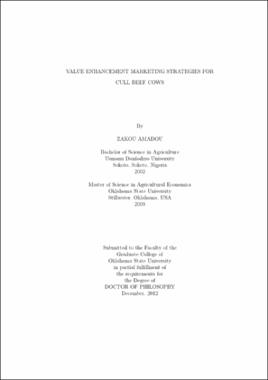| dc.contributor.advisor | Raper, Kellie Curry | |
| dc.contributor.author | Amadou, Zakou | |
| dc.date.accessioned | 2013-11-26T08:21:57Z | |
| dc.date.available | 2013-11-26T08:21:57Z | |
| dc.date.issued | 2012-12 | |
| dc.identifier.uri | https://hdl.handle.net/11244/6501 | |
| dc.description.abstract | This study compares alternative marketing strategies with the traditional practice of marketing spring-calving cull cows in the fall immediately after weaning. Specifically, this dissertation investigates value-added marketing strategies for cull cows, with particular attention on how alternative feeding systems, beginning body condition scores and marketing cull cows as bred cows instead of as slaughter cows improve the salvage value. First, this work examines the profitability of delayed marketing of cull cows held in two different retention feeding systems. In each of three culling years, net returns based on physical performance data and financial data were measured at five approximately monthly intervals for cull cows retained on stockpiled native pasture versus a low-cost dry lot setting. Results favor the lower-cost, forage-based feeding program with spring marketing over fall marketing. Low-cost weight gain coupled with seasonal increases in slaughter cow prices combined to increase net returns for retaining and feeding cows on lower-cost forage for about four months. The impact of beginning body condition scores on net returns from marketing cull cows at culling or retaining cull cows for delayed marketing is also investigated. Net returns are examined across marketing periods relative to the use of body condition score at culling as a sorting trigger. While a pasture system was generally more profitable than a low-input dry lot system, cows with lower beginning BCS were more profitable than cows with higher beginning BCS, regardless of the feeding system. Finally, this study examines whether the salvage value of cull cows can be improved by retaining cows with a bull and marketing them as bred cows instead of as slaughter cows. Results reveal that marketing cull cows as bred cows was more profitable than marketing them as slaughter cows, regardless of retention systems or retention period length, assuming the producer has the resources to do so. Additionally, while results indicate that retaining cull cows in the dry lot system was not profitable if cows were marketed as slaughter cows, the retention system becomes profitable if cull cows can be marketed as bred cows. | |
| dc.format | application/pdf | |
| dc.language | en_US | |
| dc.rights | Copyright is held by the author who has granted the Oklahoma State University Library the non-exclusive right to share this material in its institutional repository. Contact Digital Library Services at lib-dls@okstate.edu or 405-744-9161 for the permission policy on the use, reproduction or distribution of this material. | |
| dc.title | Value enhancement marketing strategies for cull beef cows | |
| dc.contributor.committeeMember | Epplin, Francis M. | |
| dc.contributor.committeeMember | Peel, Derrell S. | |
| dc.contributor.committeeMember | Biermacher, Jon T. | |
| dc.contributor.committeeMember | Lalman, David Leon | |
| osu.filename | Amadou_okstate_0664D_12516 | |
| osu.accesstype | Open Access | |
| dc.type.genre | Dissertation | |
| dc.type.material | Text | |
| dc.subject.keywords | cull cows | |
| dc.subject.keywords | livestock marketing | |
| dc.subject.keywords | retention systems | |
| thesis.degree.discipline | Agricultural Economics | |
| thesis.degree.grantor | Oklahoma State University | |
